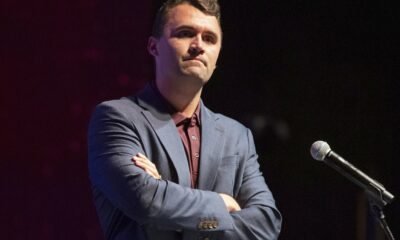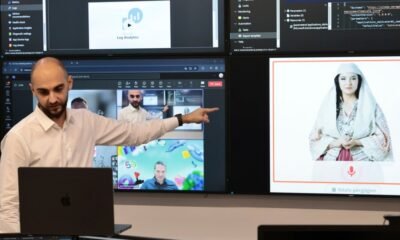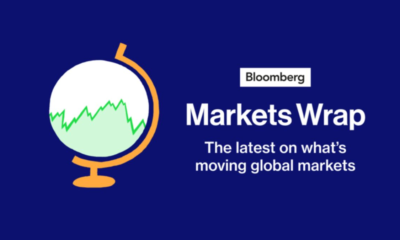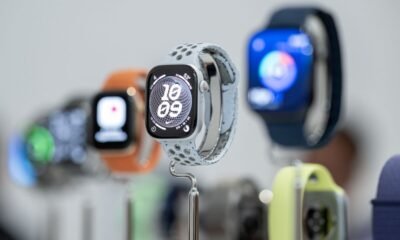Business
How Roy Jakobs is leveraging Dutch directness and the power of AI to transform Philips into a health-tech leader

CEO Agenda provides unique insights into how leaders think and lead and what keeps them busy in a world of constant change. We look into the lives, minds and agendas of CEOs at the world’s most iconic companies.
Founded in 1891 as a light bulb manufacturer, Philips has transformed itself into a health-tech leader in the 21st century. Its early work in lighting laid the foundation for the development of X-ray tubes, which became the cornerstone of its health care business.
The 134-year-old technology company faced perhaps the most significant crisis in its history following the 2021 U.S. recall of Philips breathing devices, including CPAP and BiPAP machines, owing to potential health risks. Roy Jakobs, who joined Philips in 2010, became CEO of the Dutch company in 2022, around the time of the crisis. Since then, he has helped bring the company into stabilization. While annual revenue has remained steady—reaching $19.5 billion in 2024—the company’s share price has risen a total of 81% since Jakobs took over. Though today the company’s share price remains below its 25-year average, Jakobs is committed to driving a long-term turnaround.
Alongside the recall, one of Jakobs’s first major actions as CEO was announcing a restructuring plan that cut 10,000 jobs—around 13% of the workforce—a move aimed at helping the company absorb settlement payouts.
Rising patient expectations—along with technologies like remote robotics, digital health platforms, and AI-driven machine learning—are rapidly transforming health care. In response, Jakobs is driving continuous innovation at Philips by enhancing hospital patient monitoring through IntelliVue bedside, wearable, and transport monitors—seamlessly integrated with the Philips Patient Information Center iX for real-time data access—and advancing Azurion image-guided therapy platforms to support minimally invasive procedures.
210 Philips rank on Fortune 500 Europe
“Explaining the why is very important,” he says. “It’s not about where you do innovation. It’s about the impact.” He emphasizes how crucial it is for companies to stay relevant in an ever-changing market, and to do so honestly and with integrity.
From boardrooms to soccer sidelines (he’s an avid sports enthusiast), Jakobs brings a grounded yet global mindset shaped by his (and Philips’s) Dutch heritage. Whether it’s planning his calendar around family events or sparking innovation across continents, Jakobs exemplifies what it means to lead with intent.
This interview has been edited for length and clarity.
Down to business
Fortune: Walk us through your career journey.
I started working at Shell, where I ran several operations. Then I was at Elsevier. When I joined, it was still a majority print-based business in the sciences, and it moved very rapidly.
That triggered why Philips invited me over in 2010, when lighting started to digitize rapidly and LED lighting was introduced. A major transformation from analog to digital light was starting, and Philips wanted to lead. I feel I can contribute to the heritage of strong global companies built in a small country, especially in key fields like energy, science, and health care.
How does the Dutch business style differ from that of other multinationals?
You need to think globally. There’s an outward perspective in how you engage with the world, respecting differences but also opportunities. That’s what the Dutch have been doing—going out, traveling the world, and grabbing opportunities.
The Dutch can also be very direct. I like clarity as a personal leadership style. There is value in speaking out, respectfully. There is also a part of Dutchness that is consensus-driven—you need to take many stakeholders into account if you want to do business. That’s a strength. We also think broadly—about patients, people, society, and sustainability. But at the same time, if you’re too consensus-driven, it can make you slower. That’s something to be mindful of.
You’ve led a major restructuring and significant repositioning of the business. What have you learned from the experience?
You need to be grounded in the reality you face, and if you restructure respectfully and with the right intent, you will gain support.
I had to significantly reduce headcount. In the same period, we drove our [employee] engagement score up by 12 points—because of how we did it. We were respectful and clear about why we did it and what we wanted to achieve, which was a simpler, leaner organization and to get Philips winning again.
It’s all about how you stay relevant and how you do it together with the audience you serve. Explaining the why is very important. It’s not about where you do innovation—it’s about the impact.
“There’s an outward perspective in how you engage with the world, respecting differences but also opportunities. That’s what the Dutch have been doing—going out, traveling the world, and grabbing opportunities.”
Roy Jakobs
Philips is known for consumer-facing innovation—how have you approached its communication strategy?
As a consumer brand, you have a wide reach with billions of consumers. In health care, patients are more focused on getting the best care than on the brand itself.
I’ve been refocusing the company on driving towards delivering better and more care—because the challenge in health care is only getting bigger due to the growing gap between demand and supply. I also engage with the government and relevant stakeholders on the payer side. We’ve been in health care for 100 years and are known as a trusted partner. While consumer branding differs from B2B, our legacy and ongoing activities continue to build our presence.
With challenges in China and global trade, where is your focus as CEO, and how do you navigate these tensions?
The system is under pressure as government funding shifts to energy and defense, so we need to become more efficient due to reduced health care support.
There are big differences globally—countries like the U.S. spend 20% of GDP and need efficiency, while others like Indonesia are still building up. China has been challenged since COVID because its economy has not been back in full force. The country is strengthening, but it is still not back to where it was. The U.S. still has strong health care demand and is looking for solutions.
Tariffs are also something we are dealing with. COVID made us aware of constraints, especially if you have a too long or too diversified supply chain. Since COVID we started to regionalize more. You need to be local.
How do you think we can address the productivity gap between Europe and the U.S.?
Philips is a big European company. We drive many activities in other parts of the world.
You need to have financial capital streams that support talented startups, especially in tech. It’s easier to access capital in the U.S. than in Europe. We need to [fix] that.
If you want to remain competitive, you need to have an energy cost that is competitive globally. Europe is expensive because of its heavy reliance on outside sources, including Russia. We need to strengthen our energy infrastructure.
We’ve been advocating for appropriate AI regulation that supports but does not overburden it.
Being productive
What’s your morning routine that sets you up for the day?
I get up early, play sports if I can. I want to be not only a CEO, but also a father and good husband, so careful planning is essential.
I plan my time, especially when traveling, so I can be present. I carve out time for my sons’ soccer matches and make sure to show up when it matters. A big part of staying connected, whether with customers, stakeholders, or family, is clear communication.
Coffee or tea?
I studied in Italy, so I start with a cappuccino and then shift to regular coffee or espresso. I also love tea.
Tell us a bit about your sports interests?
I like sports for many reasons. I get energy out of it, and I also like the social aspect of sports. I play soccer, tennis, and also run. I like to learn from sports, with the team.
I also think [sports] is very important, especially since we’re a health care company. So [we should] lead by example. There’s value in being fit for the energy that we need for the daily grind.
Do you have a set end to your workday? Are you strict about stopping work, or do you tend to continue with emails and tasks into the evening once you’re home?
I’m quite flexible. Running a global business means that sometimes I need to be early for China or Asia, or late for the U.S. Work and personal [life] are intertwined.
I appreciate spending time with my family on Friday nights, especially cooking dinner together.
Getting personal
What apps or methods do you use to be more productive?
I use my iPad as my notebook, and that works for me.
Courtesy of Royal Philips
Who is on your personal board?
I have a broad network of people whom I can get inspiration from. Some are friends, my professional coach, my sister. Sometimes people assume that a CEO knows everything, but I’m the first to admit if I don’t. That’s why I have a team.
As a consumer, what is your favorite company and why?
Apple. I love the combination of design and the user focus.
What is your favorite cuisine to either cook or eat?
Italian. I love eating and cooking. Living in Bologna, I learned to appreciate Italian cuisine. Simple recipes yield magnificent outcomes—we should do the same in business.
CEO Agenda provides unique insights into how leaders think and lead, and what keeps them busy in a world of constant change. We look into the lives, minds and agendas of CEOs at the world’s most iconic companies. Dive into our other CEO Agenda profiles.
Business
Amazon Bolsters AI Agent Push With 2 Executive Hires: Internal Memos

Amazon is doubling down on its agentic AI ambitions, hiring two senior executives to help build its growing portfolio of developer tools and infrastructure for intelligent agents.
The new hires follow Business Insider’s report in early September that Amazon was getting ready to make a big splash in the AI agent market, sparking a rally in the company’s shares. Amazon’s cloud computing arm, AWS, has made an aggressive move to position itself as a leader in agentic AI, where intelligent software agents build, deploy, and manage complex applications on behalf of users.
David Richardson returns to Amazon Web Services as vice president of AgentCore, the company’s foundational agent infrastructure offering. A 16-year veteran of the cloud giant, Richardson was instrumental in launching AWS’s Serverless business before departing in 2022 to lead developer experience and product platform at Stripe.
Now back, DRR, as he’s known inside Amazon, will oversee AgentCore along with related projects such as the Strands SDK and Agent Builder within Bedrock, AWS’s popular AI platform.
“We expect DRR to start other new exciting efforts in the AgentCore umbrella,” Swami Sivasubramanian, who runs the Agentic AI team at AWS, wrote in a recent internal memo announcing the hire.
Amazon declined to comment.
Joe Hellerstein, a professor at UC Berkeley and renowned database researcher, has also joined AWS as Vice President and Distinguished Scientist, according to a separate internal memo. He will play a pivotal role in advancing Kiro, AWS’s agentic integrated development environment (IDE). Kiro has quickly gained traction, attracting over 100,000 users in its first week of release.
Hellerstein’s academic work includes leadership of the Hydro project, a framework for building distributed systems. At AWS, he will focus on integrating Hydro’s principles into Kiro to strengthen the platform’s reliability and developer appeal.
“Joe will work closely with our customers to understand their needs and translate that feedback into making both Hydro and our products more impactful,” Deepak Singh, an AWS VP who oversees developer agents and experiences, wrote in an internal memo. “We are particularly excited about the possibilities of how Hydro can integrate with Kiro to help our customers build robust, high-performance distributed systems.”
Sign up for BI’s Tech Memo newsletter here. Reach out to me via email at abarr@businessinsider.com.
Business
Fueled by AI Hype, Google Becomes Fourth Company to Pass $3 Trillion Market Cap

On Monday, Google’s parent company, Alphabet, became the fourth company to reach a market value of $3 trillion, and every member of this exclusive club has something in common.
All it took was a rather small 4% rise in shares for the tech giant to hit the coveted stock market benchmark. Rather unsurprisingly, the three previous winners of that title—Nvidia, Microsoft, and Apple—are all titans of the tech industry that have been riding the wave of investor interest in AI, as well.
Alphabet stock had a great start to September after a federal judge concluded earlier this month that the tech giant could keep Chrome despite its monopoly in internet search. The judge’s reasoning for that was that generative AI would eventually pose “a meaningful challenge to Google’s market dominance.”
Google is trying to get ahead of that “meaningful challenge” by fusing AI into its search engine and pouring billions into developing its AI offerings, including its own AI chatbot Gemini.
It seems that investment cashed out for the company. As of Monday morning, Google Gemini is now the number one free app on Apple’s App Store, relegating OpenAI’s ChatGPT to number two status and giving the much-needed push to the company’s stock.
The AI hype is inextricably and intricately linked to the significant stock market returns that these tech giants, and many others, have experienced this year. The trillion-dollar question: Is there an AI bubble?
AI hype driving major gains
The best example of AI hype delivering trillions of dollars of financial gain is perhaps Nvidia, the ultimate AI darling of the stock market. Due to its immense market share in AI chips and the meteoric rise it experienced thanks to the technology, the company is largely considered the face of the AI hype.
Earlier this summer, Nvidia made history as the first company to ever hit $4 trillion market valuation.
Apple, considered the least AI-savvy of the four companies to breach the $3 trillion benchmark, was the first company to ever be worth $3 trillion but is still yet to hit $4 trillion. Meanwhile, both Nvidia and Microsoft have outperformed Apple and already reached that milestone. Microsoft’s breach of the $4 trillion benchmark was also thanks to AI.
Late July, Microsoft posted an earnings report that showed stellar revenue for its cloud computing platform Azure. The stock move following the report pushed Microsoft briefly above $4 trillion market value.
Fellow cloud infrastructure provider Oracle also benefited greatly from an AI-demand-driven stock move. Chairman Larry Ellison became the richest man on Earth last week after Oracle stock skyrocketed more than 42% on news that the company expects to collect half a trillion dollars (and potentially billions of dollars more) in the coming quarter on AI deals alone.
Is there a bubble?
All this is great news for tech companies and their financial metrics, but is it substantiated? That question has been plaguing investors for some time now.
According to some experts (and OpenAI CEO Sam Altman), there is indeed an AI bubble.
“Are we in a phase where investors as a whole are overexcited about AI?” Altman said last month in a dinner with journalists, according to The Verge. “My opinion is yes.”
An AI report from MIT fueled those worries further just a few weeks ago. The researchers shared that despite the push to scale AI in the corporate world, fewer than one in ten AI pilot programs have actually generated revenue gains.
AI is currently deployed mostly by larger firms in select fields. But even there, AI adoption is now declining, according to the latest U.S. Census Bureau findings.
If AI is indeed in a bubble, the burst could be catastrophic. So much is riding on the AI wave right now, including the entire U.S. economy.
In a paper published in July, Fed researchers said that if AI demand does not scale proportionally with investment, it can lead to “disastrous consequences,” and compared it to the railroad over-expansion of the 1800s and the economic depression that followed. Also in July, economist Torsten Slok called the AI bubble of today even worse than the 1999 Dot-com bubble.
Business
Why Walmart Is Emerging As an AI Powerhouse

Analysts have characterized the recent strength in the stock market as an AI rally, but flying under the Magnificent Seven’s radar is Walmart — a company so vast that it literally has its own weatherman.
And as it turns out, the retail juggernaut’s scale and reach are proving to be tremendous assets in the AI race.
That’s because most top AI companies — like OpenAI, Microsoft, Anthropic, or Meta — operate in a primarily virtual space, processing unfathomably complex rivers of information into more digital information. AI-adjacent companies like Nvidia, Intel, and Oracle focus on providing the physical infrastructure upon which the AI machines function. Then there are the companies that are using digital intelligence to deliver physical results through automation and augmented experiences, like Tesla and Amazon.
Walmart, by contrast, has a vast and complicated set of physical challenges to solve as the largest retailer in the US — and the world. Those include everything from cleaning up spills in the dairy aisle to stocking shelves.
“We move billions of items around every month, every year,” Walmart US CEO John Furner said Tuesday at the Fortune Brainstorm Tech conference. He said the company has been developing machine learning tools and other automation projects since around 2015.
Furner said that the company’s AI models and supply chain automation help plan inventory to arrive at the right aisle at the right time, for example. One technique involves creating “digital twins” of each facility to model the movement of merchandise through the system on its way to customers.
Furner also said store associates increasingly have an AI chatbot handy via their handheld devices to help them better set priorities and help customers.
“It’s a combination of people being powered by technology. There’s a lot of judgment to retail and decision-making. And we’re in a very dynamic industry,” he said. “We think this next phase of physical AI in combination with Gen AI is going to be really helpful.”
The company’s head of e-commerce, David Guggina, told the Goldman Sachs Communicopia and Tech conference last week how AI is helping his team run experiments and fulfill orders at an increasingly rapid rate.
Guggina said his team is now able to work at breathtaking speed behind the scenes, too.
“What took a data scientist days or weeks before can now be done in minutes,” he said.
AI also helps ensure that each of the company’s 4,700 stores has the kinds of products best suited to their local markets, slashing delivery times to minutes after a customer places an order.
“We’ve just completed the third inning,” he said by way of the classic baseball game analogy. “So we’re still early with regard to our automation journey in the fulfillment network.”
These digital-to-physical uses of AI are also complemented by a myriad of “micro agents” that handle tasks like tracking local event calendars or monitoring inventory levels.
Walmart, of course, is still fine-tuning its AI approach, and there have been hiccups.
The proliferation of bespoke Walmart-made AI agents eventually started to confuse users, the company told the Wall Street Journal.
The company has rolled many of those micro agents into four “super agents” designed to assist shoppers, merchandisers, programmers, and third-party marketplace sellers.
Still, because Walmart’s 20,000-strong global tech team builds so many of these digital and physical solutions in-house, the company is emerging as an unexpected AI powerhouse.
The company snagged former Instacart exec Daniel Danker in July to accelerate its AI efforts.
It’s also deepening its partnership this month with OpenAI via a new training program for associates and enterprise access to ChatGPT tools for frontline Sam’s Club employees to help operate their warehouse stores more smoothly.
After all, while chatbots might sometimes hallucinate answers, there’s no faking a cold gallon of milk on your doorstep.
-

 Business2 weeks ago
Business2 weeks agoThe Guardian view on Trump and the Fed: independence is no substitute for accountability | Editorial
-
Tools & Platforms1 month ago
Building Trust in Military AI Starts with Opening the Black Box – War on the Rocks
-

 Ethics & Policy2 months ago
Ethics & Policy2 months agoSDAIA Supports Saudi Arabia’s Leadership in Shaping Global AI Ethics, Policy, and Research – وكالة الأنباء السعودية
-

 Events & Conferences4 months ago
Events & Conferences4 months agoJourney to 1000 models: Scaling Instagram’s recommendation system
-

 Jobs & Careers3 months ago
Jobs & Careers3 months agoMumbai-based Perplexity Alternative Has 60k+ Users Without Funding
-

 Podcasts & Talks2 months ago
Podcasts & Talks2 months agoHappy 4th of July! 🎆 Made with Veo 3 in Gemini
-

 Education3 months ago
Education3 months agoVEX Robotics launches AI-powered classroom robotics system
-

 Education2 months ago
Education2 months agoMacron says UK and France have duty to tackle illegal migration ‘with humanity, solidarity and firmness’ – UK politics live | Politics
-

 Podcasts & Talks2 months ago
Podcasts & Talks2 months agoOpenAI 🤝 @teamganassi
-

 Funding & Business3 months ago
Funding & Business3 months agoKayak and Expedia race to build AI travel agents that turn social posts into itineraries















